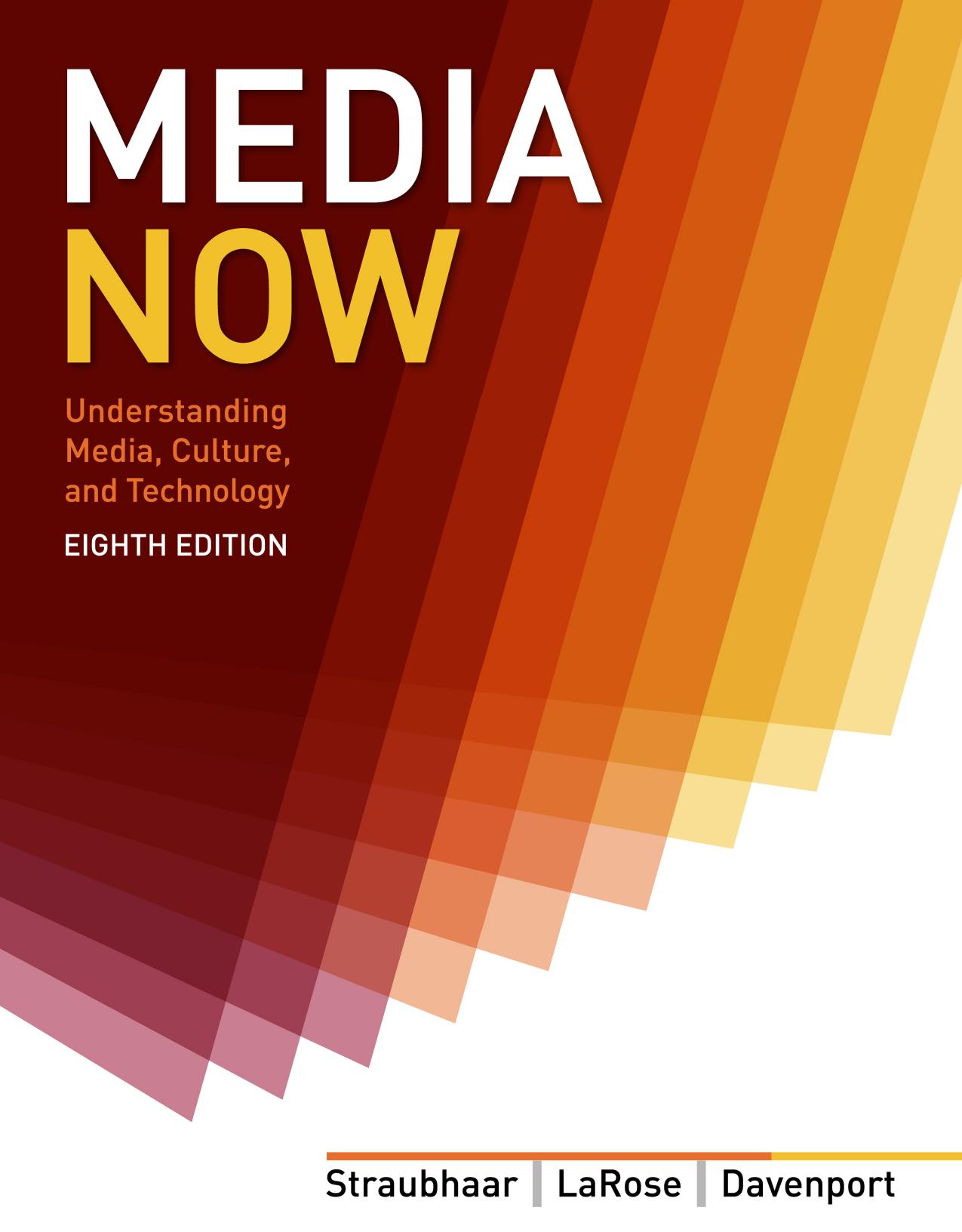Media Now Understanding Media Culture and Technology 8th by Joseph Straubhaar 1133311369 9781133311362
$70.00 Original price was: $70.00.$35.00Current price is: $35.00.
Instant download Media Now Understanding Media Culture and Technology 8th Wei Zhi after payment
Media Now Understanding Media Culture and Technology 8th by Joseph Straubhaar – Ebook PDF Instant Download/Delivery: 1133311369, 9781133311362
Full dowload Media Now Understanding Media Culture and Technology 8th after payment

Product details:
• ISBN 10:1133311369
• ISBN 13:9781133311362
• Author:Joseph Straubhaar
MEDIA NOW, Eighth Edition, empowers you to think critically about the media and its effects on culture by providing a thorough understanding of how media technologies develop, operate, converge, and affect society. MEDIA NOW prepares you for encounters in the expanding fields of the Internet, interactive media, and traditional media industries through engaging, up-to-date material that covers the essential history, theories, concepts, and technical knowledge you need to thrive. Extensively updated in a new eighth edition, MEDIA NOW provides a comprehensive introduction to today’s global media environment and ongoing developments in technology, culture, and critical theory that continue to transform this rapidly evolving industry and affect our daily lives.
Media Now Understanding Media Culture and Technology 8th Table of contents:
Part One. Media and the Information Age
Chapter 1. The Changing Media
The Media in Our Lives
Media in a Changing World
Merging Technologies
Changing Industries
Changing Lifestyles
Shifting Regulations
Rising Social Issues
Changing Media throughout History
Pre-Agricultural Society
Agricultural Society
Industrial Society
Information Society
After the Information Society
Digital Media Evolution
Changing Conceptions of the Media
The SMCR Model
Interactive Media
Types of Communication
What Are the Media Now?
Summary & Review
Thinking Critically about the Media
Key Terms
Chapter 2. Media and Society
Understanding the Media
Media Economics
Mass Production, Mass Distribution, Mass Audiences
Digital Media Economics
The Benefits of Competition
Media Monopolies
The Profit Motive
How Media Make Money
From Mass Markets to Market Segments
From Mass Market Segments to Social Media
Critical Studies
Political Economy
Feminist Studies
Ethnic Media Studies
Media Criticism
Diffusion of Innovations
Why Do Innovations Succeed?
How Do Innovations Spread?
What Are the Media’s Functions?
Surveillance
Media and Public Opinion
Gatekeeping
Agenda Setting
Framing
Technological Determinism
The Medium Is the Message
Technology as Dominant Social Force
Media Drive Culture
Summary & Review
Thinking Critically about the Media
Key Terms
Part Two. The Media
Chapter 3. Books
History: From Ink to Digital, From Press to Computer
Early Print Media
The Gutenberg Revolution
The First American Print Media
Publishing Houses and Books Evolve
Artificial Intelligence
Traditional and Independent Publishing Houses
Self-Publishing and Vanity Presses
Retail Bookstores
What’s to Read?: Publishing Divisions, Book Genres, and Book Forms
Book Publishing Divisions
Book Genres
Book Forms
Who Reads What Books?
Top-Selling and Most Popular Books of All Time
Book Publishing Industry Economics
Global Book Sales: The Coronavirus Domino Effect
U.S. Book Sales
Media Literacy: What Is Media Literacy?
But First: The Ability to Read Is Important
Books as Ideas
Public Libraries, Freedom of Speech, and Banning Books
Summary & Review
Thinking Critically about the Media
Key Terms
Chapter 4. Print and e-Newspapers
History: Journalism in the Making
Newspapers Emerge
The Colonial and Revolutionary Freedom Struggles
The First Amendment
Diversity in the Press
The Penny Press
Following the Frontier
Handwritten Newspapers
Civil War Coverage
The New Journalism
Yellow Journalism
Responsible Journalism
Muckraking
Chain Ownership and Conglomerates
Professional Journalism
The Watchdogs
Technology Trends
News Gathering
Printing: Traditional Offset and Digital
E-Newspapers and Digital Natives: News-on-Demand
Immersive Journalism: Virtual Reality and Augmented Content
AI News Feed Algorithms: News Aggregators
Industry: The News Landscape
News Consumers Habits
Competition for Audiences and Advertisers
An Evolving Business Model
Public Trust in the News
Content: What Is News?
Defining News
News Values
Print and E-Newspapers
Audiences and News Content
Media Literacy: Monopolies, Ethics, Gatekeeping, and Fake News
News Monopolies
Journalism Ethics
News Editors and Gatekeeping
Tips for Identifying Fake News
Summary & Review
Thinking Critically about the Media
Key Terms
Chapter 5. Magazines
History
Early Magazines
America Reads
Muckraking
Magazines Evolve
Magazines Move from General to Specialized Audiences
Business During the Great Recession and the COVID-19 Pandemic
Technology Trends: Printing and Publishing
Industry
Individual Owners to Conglomerates
Print and Digital Formats
Single-Sales, Distribution, and Marketing
Content and Audiences
Audiences
Audience Demographics
Economics of Circulation and Advertising
Advertising
Subscriptions
Single-Copy Sales
The Role of Magazines and Trends
Media Literacy: Intellectual Property and Copyright
Summary & Review
Thinking Critically about the Media
Key Terms
Chapter 6. Recorded Music
History: From Roots and Records to Sounds in the Cloud
The Victrola
Early Recorded Music
Big Band and the Radio Days
Big Band Music and the World War II Generation
New Musical Genres
Rock and Pop History
The Record Boom and Pop Music
The Rock Revolution Will Be Segmented
Digital Recording
Music on the Internet
Artificial Intelligence–Generated Music
Technology Trends: Let’s Make Music
New Digital Formats
Sinking the Pirates
Streaming and Cloud Music Services
Social Music Media
The Recording Industry
The Talent
Recording Studios and Record Companies
Music Distribution
Concerts and Concert Promotion
Music Industry Associations
Media Literacy: Who Controls the Music? Recorded Music in the Age of the New Media Giant
Sharing or Stealing?
Pity the Underpaid Artists
Getting Distributed Means Getting Creative
Music Censorship?
Global Impact of U.S. Pop Music Genres
Summary & Review
Thinking Critically about the Media
Key Terms
Chapter 7. Radio
History: How Radio Began
Save the Titanic: Wireless Telegraphy
Regulation of Radio
Broadcasting Begins
BBC, Radio Moscow, and the Roads Not Taken
Radio Networks
Paying for Programming: The Rise of Radio Networks
Radio Network Power
Competition from Television
Networks Fall, Disc Jockeys Rule
The FM Revolution
Local DJs Decline: A New Generation of Network Radio
New Genres: Alternative, Rap, and Hip-Hop Radio
Radio in the Digital Age
Podcasting
Current Broadcast Radio
Technology Trends: Inside Your Radio
From Marconi’s Radio to Your Radio
High-Definition Radio
Satellite Radio Technology
Internet Radio Trends
Weighing Your Digital Radio Options
Industry: Radio Stations and Groups
Radio in the Age of the New Media Giants
Inside Radio Stations
Noncommercial Radio
Genres around the Dial
Radio Formats
The Role of Radio Ratings
Music Genres and Radio Formats
Talk Radio
National Public Radio
Radio Programming Services
Media Literacy: The Impact of the Airwaves
Who Controls the Airwaves?
Concentrating Ownership, Reducing Diversity?
You Can’t Say That on the Radio
Who Owns the Music?
Summary & Review
Thinking Critically about the Media
Key Terms
Chapter 8. Film and Video
History: Golden Moments of Film
How to Use Images: Silent Films Set the Patterns
Setting Up a System: Stars and Studios
How to Use Sound: Look Who’s Talking
The Peak of Movie Impact?
The Studio System: The Pros and Cons of Vertical Integration
Film Faces Television, 1948–1960
Studios in Decline
Hollywood Meets HBO
Movies Go Digital
Independent Film Production
Technology Trends: Making Movie Magic
Movie Sound
Special Effects
The Digital Revolution
Movie Viewing
The Film Industry: Making Movies
The Players
Independent Filmmakers
The Guilds
Film Finance
Film Distribution
Telling Stories: Film Content
Team Effort
Finding Audience Segments
Media Literacy: Film and Our Society
Violence, Sex, Profanity, and Film Ratings
Viewer Ethics: Film Piracy
Summary & Review
Thinking Critically about the Media
Key Terms
Chapter 9. Television
History: TV Evolves
When Television Was New
Into the Wasteland
Washington to the Rescue?
New Media to the Rescue?
The Big Three in Decline
Television Enters the Information Age
Technology Trends: From a Single Point of Light
Digital Television Is Everywhere
Are We Ready for Next-Gen TV?
Video Recording
Video Production Trends
Industry: Who Runs the Show?
Video Production
National Television Distribution
Local Television Distribution
Noncommercial Stations
Television Advertisers
Genres: What’s on TV?
Broadcast Genres and Beyond
What’s on Cable?
PBS Programming
Programming Strategies
Media Literacy: Out of the Wasteland at Last?
The New Television Hegemony
Is It Time to Cut the Cable Cord?
Is Television Decent?
Children and Television
Will Public Television Survive?
Can Broadcast Television Survive?
Television Needs You!
Summary & Review
Thinking Critically about the Media
Key Terms
Chapter 10. Social Media
History: From Cave Painting to Facebook
Social Media before the Information Age
Mobile Communication Catches On
Social Media in the Information Age
Third-Generation Social Media
Fourth Generation: Social Networking Arrives
A Third Screen Enters Our Lives
Technology Trends
Dial-Up Days
Meeting the Need for Speed
Bandwidth on the Move
Protocol Evolution
Smartphone Gadgetry
Industry: The Social Media Economy
Tech Giants in Social Media
Internet Service Providers
Content Creators Wanted
Social Media Genres
Media Literacy: Social Media Challenges for Society
Ready or Not Here Comes Artificial Intelligence
Censorship
Smartphone Addiction?
Child Protection
Protecting the Rest of Us
Who Runs the Internet Now?
Social Media Safety
Summary & Review
Thinking Critically about the Media
Key Terms
Chapter 11. Video Games
History: Getting Game
Opening Play
Home Games
Personal Computers Get in the Game
Gear Wars
Invasion of the Handhelds
The Current State of Play
Technology Trends: The Next Level
Generations Past
Gaming on a Cloud
The Need for Speed and 5G
Mixed Reality Enters the Game
The AI Game
Industry: The Game Players
Gear Makers
Game Publishers
Game Developers
Distributors: Selling the Game
Video Game Genres: Joys of the Game
Media Literacy: Spoiling the Fun?
Beyond Barbie
More Addictive Than Drugs?
More Harmful to Children Than TV?
Serious Games?
Summary & Review
Thinking Critically about the Media
Key Terms
Chapter 12. Public Relations
Public Relations Yesterday and Today
History: Civilizations and Their Public Relations
The American Way
From Entrepreneurs to Governments
PR Pioneers in the Modern World
Public Relations Matures
Global Public Relations
Industry: Inside the PR Profession
PR Agencies and Corporate Communications
PR Publics, Subspecialties, and Media Skills
Publics and Stakeholders
Public Relations Subspecialties
PR Media Skills
PR Communication and Campaign Models
Four Models of Public Relations
Phases of a Campaign
Technology Tools for Getting the Job Done
Media Tool Kits and Online Press Rooms
News Releases
Video News Releases
Social Media
Webcasts
Podcasts
Satellite Media Tours
E-Mails
Texts and Simple Message Services
Online PR Services
Professional Development
Professional Resources
Media Literacy: Public Relations and Ethics
Personal Ethics in the Profession
The Public’s Best Interests versus Corporate Interest
Artificial Intelligence and Media
AI and Public Relations
Summary & Review
Thinking Critically about the Media
Key Terms
Part Three. Media Issues
Chapter 13. Advertising
History: From Handbills to Mobile Ads
Advertising in America
The Origins of the Advertising Profession
The Rise of Broadcast Advertisers
Hard Sell versus Soft Sell
Integrated Marketing Communications
Advertising Now
Technology Trends: Changing Advertising Media
Advertising Goes Digital
The Digital Advertising Ecosystem
Direct Response Advertising
Advertising Everywhere
Industry: Inside Advertising
Advertisers
Inside the Advertising Agency
Advertising Media
Inside the Digital Ecosystem
Advertising Research and Measurement
Content: Advertising’s Forms of Persuasion
Mining Pop Culture
Consumer-Generated Content
Relationship Marketing
Direct Marketing
Communication Objectives
Understanding Consumer Needs
The Changing Nature of the Consumer
Global Advertising
Media Literacy: Analyzing Advertising
Hidden Persuaders
Privacy
Deception
Advertising Harmful Products
Diversity in Advertising
Children and Advertising
Summary & Review
Thinking Critically about the Media
Key Terms
Chapter 14. Media Uses and Impacts
Bashing the Media
Media Research Methods
Contrasting Approaches
Content Analysis
Experiments
Survey Research
Ethnographic Research
Big Data
Media Research Theories
Theories of Media Usage
Theories of Media Impacts
Individual Media Impacts
Violent Behavior
Sexual Behavior
Stereotyping
Well-Being
Positive Media Effects
Understanding Societal Impacts
Social Inequality
Public Health
Community
Political Communication
The Economy
Summary & Review
Thinking Critically about the Media
Key Terms
Chapter 15. Media Policy and Law
Guiding the Media
Communications Policies
Freedom of Speech
Protecting Privacy
Protecting Intellectual Property
Competition Issues
Universal Service
Who Owns the Spectrum?
Technical Standards
The Policymaking Process
Federal Regulation and Policymaking
State and Local Regulation
Lobbies
The Fourth Estate
Summary & Review
Thinking Critically about the Media
Key Terms
Chapter 16. Media Ethics
Ethical Thinking
Ethical Principles
Thinking Through Ethical Problems: Potter’s Box
Codes of Ethics
The Principles behind Codes of Ethics
Making Ethics Work
Corporate Role-Modeling
Ethical Issues
Journalism Ethics
Ethical Entertainment
Social Media Ethics
Public Relations Ethics
Advertising Ethics
Research Ethics
Audience Ethics
Summary & Review
Thinking Critically about the Media
Key Terms
Chapter 17. Global Communications Media
Acting Globally, Regionally, and Nationally
Globalization
Regionalization
Cultural Proximity
National Production
The Global Media
News Agencies
Radio Broadcasting
Music
Film
Video
Television
Cable, Satellite, and Streaming TV
Telecommunications Systems
Computer and Tablet Access
The Internet
International Regulation
Media Literacy: Whose World Is It?
Political Economy of the Internet
Political Economy of Cultural Imperialism
Cultural Impact of Media and Information Flows
Free Flow of Information
Trade in Media
Hacking and Cyber-Warfare
Media and National/Local Development
Summary & Review
Thinking Critically about the Media
Key Terms
References
Still need help?
Find your rep
People also search for Media Now Understanding Media Culture and Technology 8th:
media now understanding media
media now understanding media culture and technology 11th edition
media now understanding media culture and technology 10th edition
media now understanding media culture and technology 11th edition pdf
media now understanding media culture and technology 10th edition pdf


